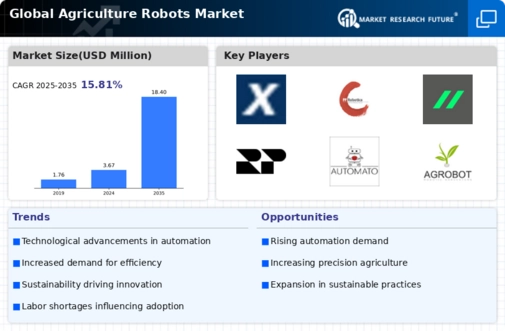Agriculture Robots Market Summary
As per Market Research Future Analysis, the Global Agriculture Robots Market was valued at USD 3665.60 million in 2024 and is projected to reach USD 18426.18 million by 2035, growing at a CAGR of 15.81% from 2025 to 2035. The market is driven by the increasing need for precision farming, labor shortages, and sustainable agriculture practices. Agricultural robots, or agribots, enhance productivity and reduce environmental impact through advanced technologies like AI and IoT. They perform various tasks including planting, harvesting, and monitoring crop conditions, thus transforming traditional farming methods.
Key Market Trends & Highlights
The integration of AI and IoT is significantly boosting the agricultural robots market.
- Single-functioned agriculture robots accounted for 70.6% of the market in 2022.
- Europe held the highest market share at 57.1% in 2022.
- The demand for weeding robots is driven by the need to reduce herbicide reliance.
- Multi-functioned robots are gaining traction for their operational efficiency and labor savings.
Market Size & Forecast
| 2024 Market Size | USD 3665.60 million |
| 2035 Market Size | USD 18426.18 million |
| CAGR (2024-2035) | 15.81% |
Major Players
Key players include XMACHINES, FFRobotics, Nafo Technologies, Nexus Robotics, Ecorobotix SA, ROBOTICS PLUS, Automato Robotics, Advanced Farms Technologies, Inc, AgXeed B.V., Agrobot, Korechi Innovations, FarmDroid.

















